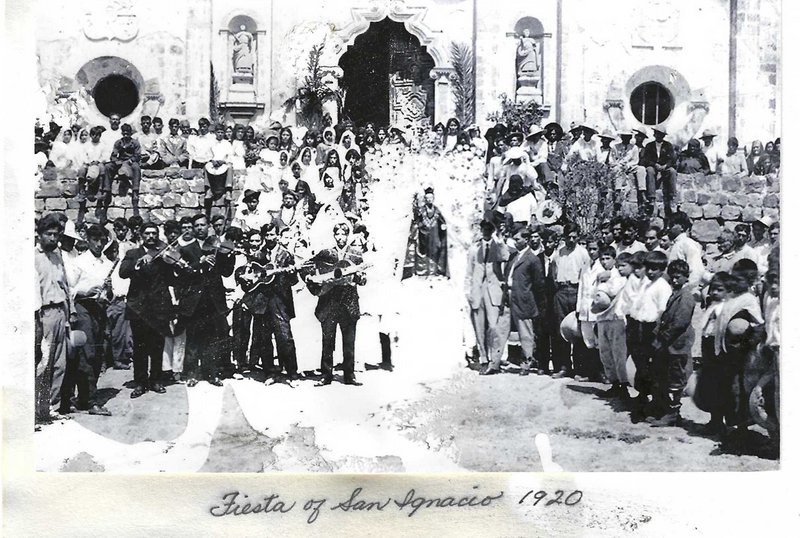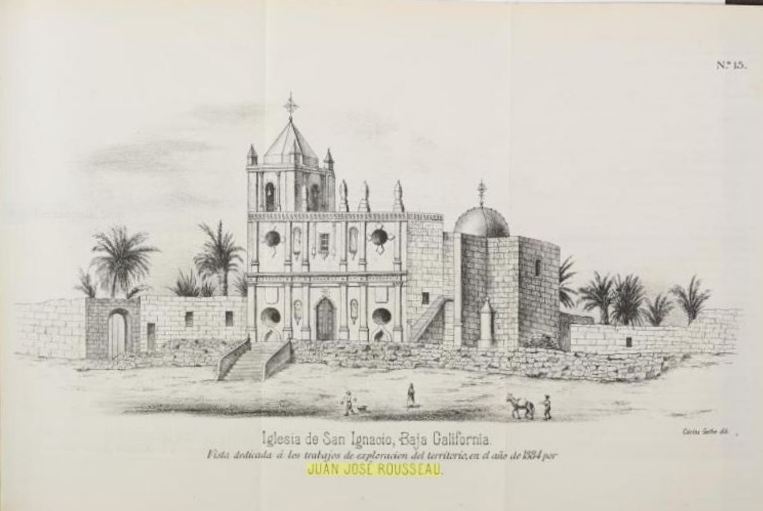
John M - 9-1-2023 at 07:39 AM

The traditional Fiesta of San Ignacio continues today during the last week of July. Each afternoon a procession winds through the streets, following
the figure of Saint Ignacius of Loyola, founder of the Jesuit order. San Ignacio was a soldier in his youth and the ancient march recalls the effort
against the devil “Luzbel” with his black ennants and the trumpets of war.
Beautiful women from San Ignacio, and the Pacific Coast communities of La Laguna, Punta Abreojos, La Bocana, Bahia Asuncion and Guerrero Negro enter a
contest for queen and lend their enchantment and elegance to the evenings.
The fiesta is a time for far-flung family members to return to San Ignacio to renew ties with the community. Children revel in the carnival rides down
in the arroyo by the mission. In the evening and through the night dancers enjoy the music of the band under the softly-lit giant Laurels of India in
the plaza.
Source: Archivo de San Ignacio, Baja California Sur
A view from a different angle, 1960s:
“By chance we had arrived in the middle of a fiesta…Both the plaza and the marketplace overflowed with people.
“Firecrackers, sounding as if the Martians had landed and invaded, awakened us at dawn the next morning. First came a religious parade, everyone
very humble and devout. Women, their elbows supported by family members, crawled on their knees along the street and into the mission, leaving bloody
trails behind them.
“The market area was a changing kaleidoscope of color. New stalls crowded in wheresoever four poles and some sort of awning could be erected…
“Perhaps because so much of my work has been tombs, crypts, graves of all kinds, I am drawn to burial grounds…I was made aware of the long-term
life of the village. Rude wooden crosses, too ancient and weathered to decipher the carvings, probably went back to the mission days… From the
overwhelming number of little mounds, it was obvious the mortality of infants and young children had been heart-breakingly excessive. I picked wild
flowers for many of them and pulled a few weeds.”
Excerpted from: Fiestas Are Not for Sleeping, Marion Smothers, 1960

San Ignacio sketch by Juan Jose Rousseau, 1884, during an exploration of the territory.
John M
[Edited on 9-1-2023 by John M]
Udo - 9-1-2023 at 09:04 AM

David K - 9-1-2023 at 10:30 AM

Another celebration
John M - 9-1-2023 at 12:20 PM
This from Bolivia
One of the more well-documented St Ignacio celebrations takes place in Moxos, Bolivia. Its significance has earned it a place on the Representative
List of the Intangible Cultural Heritage of Humanity sites and events.
Every year, the inhabitants, both young and old, of San Ignacio de Moxos in Bolivia celebrate Ichapekene Piesta, a syncretic festival that
reinterprets the Moxeño founder myth of the Jesuit victory of Ignacio de Loyola and melds it with indigenous beliefs and traditions.
The festivities begin in May with firework displays, singing and praises, and continue in July with daily and nightly celebrations of masses, funeral
wakes, alms-giving and feasts. The main representation of the victory of Saint Ignatius involves twelve sun warriors, wearing spectacular feathers,
who battle the guardians of the holy flag – the original ‘owners’ of the forest and water – before converting them finally to Christianity.
These rites are an act of faith and constant rebirth, allowing the Moxeños to be reborn into the Christian tradition in the presence of the spirits
of their ancestors.
The main procession involves 48 groups of participants disguised as masked ancestors and animals, reinforcing the importance of respect for nature.
They play tricks and dance to the accompaniment of the Baroque-era music of the Jesuit missions, then around midnight fireworks pop from the top of
their wide-brimmed hats, symbolizing the gift of light and vision to live respectfully.
A 10-minute video clip (in Spanish)
-
https://ich.unesco.org/en/RL/ichapekene-piesta-the-biggest-f...
When the link opens, you need to click on the photo of the woman dressed in purple.
unesco Intangible Cultural Heritage of Humanity sites and events around the world are made up of those elements that help demonstrate the diversity of
a particular heritage and raise awareness about its importance. Classifications range from Mythology, Masks, Costumes, Oral Tradition and Expression -
among dozens of other areas.
John M




